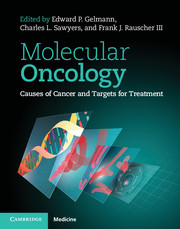Book contents
- Frontmatter
- Dedication
- Contents
- List of Contributors
- Preface
- Part 1.1 Analytical techniques: analysis of DNA
- Part 1.2 Analytical techniques: analysis of RNA
- Part 2.1 Molecular pathways underlying carcinogenesis: signal transduction
- Part 2.2 Molecular pathways underlying carcinogenesis: apoptosis
- Part 2.3 Molecular pathways underlying carcinogenesis: nuclear receptors
- Part 2.4 Molecular pathways underlying carcinogenesis: DNA repair
- Part 2.5 Molecular pathways underlying carcinogenesis: cell cycle
- Part 2.6 Molecular pathways underlying carcinogenesis: other pathways
- Part 3.1 Molecular pathology: carcinomas
- Part 3.2 Molecular pathology: cancers of the nervous system
- Part 3.3 Molecular pathology: cancers of the skin
- Part 3.4 Molecular pathology: endocrine cancers
- Part 3.5 Molecular pathology: adult sarcomas
- Part 3.6 Molecular pathology: lymphoma and leukemia
- 68 Molecular pathology of lymphoma
- 69 The molecular basis of acute myeloid leukemia
- 70 Molecular oncology of acute promyelocytic leukemia (APL)
- 71 Acute lymphoblastic leukemia (ALL)
- 72 B-cell chronic lymphocytic leukemia
- 73 Chronic myeloid leukemia: imatinib and next-generation ABL inhibitors
- 74 Multiple myeloma
- 75 EMS: the 8p11 myeloproliferative syndrome
- 76 JAK2 and myeloproliferative neoplasms
- Part 3.7 Molecular pathology: pediatric solid tumors
- Part 4 Pharmacologic targeting of oncogenic pathways
- Index
- References
75 - EMS: the 8p11 myeloproliferative syndrome
from Part 3.6 - Molecular pathology: lymphoma and leukemia
Published online by Cambridge University Press: 05 February 2015
- Frontmatter
- Dedication
- Contents
- List of Contributors
- Preface
- Part 1.1 Analytical techniques: analysis of DNA
- Part 1.2 Analytical techniques: analysis of RNA
- Part 2.1 Molecular pathways underlying carcinogenesis: signal transduction
- Part 2.2 Molecular pathways underlying carcinogenesis: apoptosis
- Part 2.3 Molecular pathways underlying carcinogenesis: nuclear receptors
- Part 2.4 Molecular pathways underlying carcinogenesis: DNA repair
- Part 2.5 Molecular pathways underlying carcinogenesis: cell cycle
- Part 2.6 Molecular pathways underlying carcinogenesis: other pathways
- Part 3.1 Molecular pathology: carcinomas
- Part 3.2 Molecular pathology: cancers of the nervous system
- Part 3.3 Molecular pathology: cancers of the skin
- Part 3.4 Molecular pathology: endocrine cancers
- Part 3.5 Molecular pathology: adult sarcomas
- Part 3.6 Molecular pathology: lymphoma and leukemia
- 68 Molecular pathology of lymphoma
- 69 The molecular basis of acute myeloid leukemia
- 70 Molecular oncology of acute promyelocytic leukemia (APL)
- 71 Acute lymphoblastic leukemia (ALL)
- 72 B-cell chronic lymphocytic leukemia
- 73 Chronic myeloid leukemia: imatinib and next-generation ABL inhibitors
- 74 Multiple myeloma
- 75 EMS: the 8p11 myeloproliferative syndrome
- 76 JAK2 and myeloproliferative neoplasms
- Part 3.7 Molecular pathology: pediatric solid tumors
- Part 4 Pharmacologic targeting of oncogenic pathways
- Index
- References
Summary
Introduction
The “8p11 myeloproliferative syndrome” (EMS) is an extremely rare hematological malignancy characterized by disruption and constitutive activation of fibroblast growth-factor receptor type 1 (FGFR1; 1). The disease is also referred to as “stem-cell leukemia/lymphoma syndrome” (SCLL) or “myeloid and lymphoid neoplasms with FGFR1 abnormalities” (ICD-O code 9967/3; 2,3). Clinically, EMS is typically a biphenotypic disorder that may present as a myeloproliferative neoplasm, acute leukemia or lymphoblastic lymphoma, usually in conjunction with prominent eosinophilia. Although uncommon, EMS is of interest because of its stem-cell origin, marked genotype/phenotype correlations and diverse range of FGFR1 fusions, which all demonstrate a common pathogenic mechanism. Cell-line and animal studies have dissected the signaling pathways that are critical for transformation and may ultimately lead to molecularly targeted therapy.
Clinical features
Clinical and laboratory descriptions of more than 40 cases of EMS have been published and, although the clinical course is highly variable, some common features have emerged, as summarized in Table 75.1. The age range at onset is between 5 months and 84 years, with a median of 32 and a slight male to female predominance of 1.5:1. EMS may present as a myeloid and/or lymphoid malignancy; the myeloid presentation may be either a myeloproliferative neoplasm (MPN) or acute myeloid leukemia (AML), and the lymphoid presentation is typically either B-cell acute lymphoblastic leukemia (B-ALL) or T-cell lymphoblastic lymphoma (T-LBL).
- Type
- Chapter
- Information
- Molecular OncologyCauses of Cancer and Targets for Treatment, pp. 809 - 817Publisher: Cambridge University PressPrint publication year: 2013

